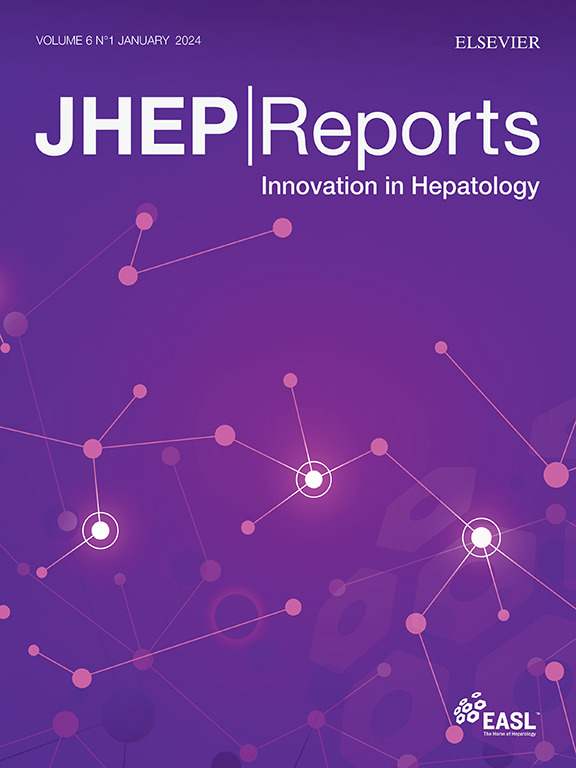MetALD: Clinical aspects, pathophysiology and treatment
IF 9.5
1区 医学
Q1 GASTROENTEROLOGY & HEPATOLOGY
引用次数: 0
Abstract
Metabolic dysfunction-associated steatotic liver disease (MASLD) and alcohol-related liver disease (ALD) are the most prevalent causes of chronic liver disease worldwide. Both conditions have many pathophysiological mechanisms in common, such as altered lipid and bile acid metabolism, and share some similar clinical features. Furthermore, metabolic risk factors and alcohol often co-exist in the same individuals and have recently been shown to act synergistically to markedly increase the risk of liver disease. Given the high prevalence and impact of this interaction, steatotic liver disease due to the combination of metabolic dysfunction and moderate-to-high alcohol intake has been termed MetALD in the new steatotic liver disease nomenclature, attracting the interest of the scientific community. Subsequent studies have investigated the prevalence of MetALD, which ranges from 1.7% to 17% in cohorts of patients with steatotic liver disease, depending on the population setting and study design. A few cohort studies have also assessed the prognosis of this patient population, with preliminary data suggesting that MetALD is associated with an intermediate risk of liver fibrosis, decompensation and mortality among steatotic liver disease subtypes. In this review article, we examine the clinical evidence and the experimental models of MetALD and discuss the clinical implications of the term for early detection and management. We provide insight into the pathophysiological mechanisms of the synergistic effect of alcohol and metabolic risk factors, possible screening strategies, the use of biomarkers and emerging models of care, as well as potential therapeutic interventions with a special focus on medications for MASLD, highlighting the most promising drugs for patients with MetALD.

MetALD:临床、病理生理及治疗。
代谢功能障碍相关脂肪变性肝病(MASLD)和酒精相关肝病(ALD)是世界范围内最常见的慢性肝病病因。这两种疾病有许多共同的病理生理机制,如脂质和胆汁酸代谢的改变,并有一些相似的临床特征。此外,代谢危险因素和酒精常常同时存在于同一个体中,最近的研究表明,它们协同作用,显著增加肝脏疾病的风险。鉴于这种相互作用的高患病率和影响,由于代谢功能障碍和中高酒精摄入的结合引起的脂肪变性肝病在新的脂肪变性肝病命名中被称为MetALD,引起了科学界的兴趣。随后的研究调查了MetALD的患病率,根据人群环境和研究设计,在脂肪变性肝病患者队列中,MetALD的患病率从1.7%到17%不等。一些队列研究也评估了这类患者的预后,初步数据表明,在脂肪变性肝病亚型中,MetALD与肝纤维化、失代偿和死亡的中等风险相关。在这篇综述文章中,我们检查了MetALD的临床证据和实验模型,并讨论了该术语的早期发现和治疗的临床意义。我们提供了酒精和代谢危险因素协同作用的病理生理机制,可能的筛查策略,生物标志物的使用和新兴的护理模式,以及潜在的治疗干预措施,特别关注MASLD的药物治疗,突出了MetALD患者最有希望的药物。
本文章由计算机程序翻译,如有差异,请以英文原文为准。
求助全文
约1分钟内获得全文
求助全文
来源期刊

JHEP Reports
GASTROENTEROLOGY & HEPATOLOGY-
CiteScore
12.40
自引率
2.40%
发文量
161
审稿时长
36 days
期刊介绍:
JHEP Reports is an open access journal that is affiliated with the European Association for the Study of the Liver (EASL). It serves as a companion journal to the highly respected Journal of Hepatology.
The primary objective of JHEP Reports is to publish original papers and reviews that contribute to the advancement of knowledge in the field of liver diseases. The journal covers a wide range of topics, including basic, translational, and clinical research. It also focuses on global issues in hepatology, with particular emphasis on areas such as clinical trials, novel diagnostics, precision medicine and therapeutics, cancer research, cellular and molecular studies, artificial intelligence, microbiome research, epidemiology, and cutting-edge technologies.
In summary, JHEP Reports is dedicated to promoting scientific discoveries and innovations in liver diseases through the publication of high-quality research papers and reviews covering various aspects of hepatology.
 求助内容:
求助内容: 应助结果提醒方式:
应助结果提醒方式:


